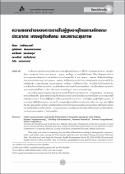บทคัดย่อ
การศึกษาตรวจสอบความแตกต่างของการตายของผู้สูงอายุไทยอายุ 60 ปีขึ้นไป ตามลักษณะประชากร เศรษฐกิจ สังคม และสุขภาพ ในช่วง พ.ศ. 2547-2549 จากข้อมูล 2 แหล่งที่เชื่อมโยงกัน ได้แก่ ข้อมูลผลการสำรวจสภาวะสุขภาพอนามัยของประชาชนไทยโดยการตรวจร่างกายครั้งที่ 3 พ.ศ. 2546-2547 ซึ่งเชื่อมโยงกับข้อมูลการตายจากทะเบียนราษฎร พ.ศ. 2547-2549 ตัวชี้วัดสถานะทางประชากร เศรษฐกิจสังคม และสุขภาพที่ใช้ คือ เขตที่อยู่อาศัย ภาคของประเทศ สถานภาพสมรส การศึกษา รายได้ของครัวเรือน ภาวะพึ่งพาในกิจวัตรประจำวัน ภาวะพึ่งพาในการทำกิจกรรมในบ้าน และปัจจัยเสี่ยงการเกิดโรคหัวใจและหลอดเลือด และเปรียบเทียบความแตกต่างของการตายตามตัวชี้วัดต่างๆ ด้วย "อัตราส่วนการตายปรับฐาน" แยกระหว่างชายกับหญิง ผลการศึกษาแสดงความแตกต่างของการตายตามตัวชี้วัดสถานะทางประชากร เศรษฐกิจสังคม และสุขภาพ ยกเว้นเขตที่อยู่อาศัย ผู้สูงอายุชายและหญิงที่อาศัยอยู่ในภาคตะวันออกเฉียงเหนือและภาคเหนือมีอัตราการตายสูงกว่าผู้ที่อาศัยอยู่ในภาคกลาง ในขณะที่ผู้ที่อยู่ในภาคใต้และกรุงเทพฯ มีการตายต่ำกว่า ยกเว้นผู้สูงอายุหญิงที่อยู่ในกรุงเทพฯ การตายสูงกว่าผู้ที่อยู่ในภาคกลาง นอกจากนี้การตายของผู้สูงอายุที่มีสถานภาพสมรสคู่ หม้าย หย่า แยก สูงกว่าผู้ที่อยู่เป็นโสด. ผู้สูงอายุที่มีภาวะพึ่งพา หรือมีปัจจัยเสี่ยงการเกิดโรคหัวใจและหลอดเลือด มีการตายที่สูงกว่าผู้ที่ไม่มีภาวะพึ่งพาและไม่มีปัจจัยเสี่ยงการเกิดโรคหัวใจ ความแตกต่างของการตายที่พบเหล่านี้สะท้อนให้เห็นว่ายังมีความไม่เท่าเทียมกันระหว่างประชากรกลุ่มต่างๆ ในประเทศไทย
บทคัดย่อ
This study was aimed at assessing the mortality differential according to demographic, socio-economic
and health status among the Thai elderly (aged 60 years and older) during the period 2004 and
2006. The data used were from the National Health Examination Survey III, 2004 (NHES III) and death
registry between 2004 and 2006. Area of residence, geographical area, marital status, education, house-hold income, dependence on daily activities of living and cardiovascular risk factors
were selected as demo-socioeconomic and health status indicators. The standardized
mortality ratio (SMR) was used to measure old-age mortality according to these indicators,
disaggrageted by sex.
It was found that mortality differences existed in almost all demo-socioeconomic
and health status indicators of the Thai elderly, except area of residence. Male and female
elderly people who lived in northeastern and northern Thailand had higher mortality,
while those who lived in the southern part of the country and Bangkok had lower
mortality than those who lived in the central region. Furthermore, the elderly who had
always been married, widowed, divorced or separated had higher mortality than those
who had always been single. The dependent elderly or those with cardiovascular (CV)
risk factors had higher mortality than those who were not dependent or who did not
have CV risk factors. These mortality differences could reflect health inequality among
different groups of the Thai population.


